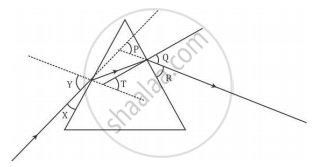Advertisements
Advertisements
प्रश्न
In the following diagram, the path of a ray of light passing through a glass prism is shown:

In this diagram the angle of incidence, the angle of emergence and the angle of deviation respectively are (select the correct option):
(A) X, R and T
(B) Y, Q and T
(C) X, Q and P
(D) Y, Q and P
उत्तर
The angle made by the incident ray with the normal to the first face of the prism is called incident angle, which is angle Y here.
The angle made by the emergent ray with the normal to the surface when it comes out from the prism after refraction is called emergent angle, which is angle Q here.
The angle between the incident ray and the emergent ray is called angle of deviation, which is angle P here.
Hence, the correct option is D.
APPEARS IN
संबंधित प्रश्न
Define the term dispersion of white light.
In the formation of spectrum of white light by a prism:
which colour is deviated least?
Out of the following, the colour of light having the maximum wavelength is:
(a) violet
(b) indigo
(c) green
(d) orange
Why do you not see a spectrum of colours when light passes through a flat pane of glass?
Which is optically denser: water or air? Give reason
Out of air and glass, which is optically rarer? Give reason.
You are given a disc divided into seven sectors with colours violet, indigo, blue, green, yellow, orange and red in them. What would be its colour when it is rotated rapidly?
The frequency range of visible light is from 3.75 × 1014 Hz to 7.5 × 1014 Hz. Calculate its wavelength range. Take speed of light = 3 × 108 m/s.
The splitting of white light in to seven colors is called ______.
What is dispersion? Explain in detail.
